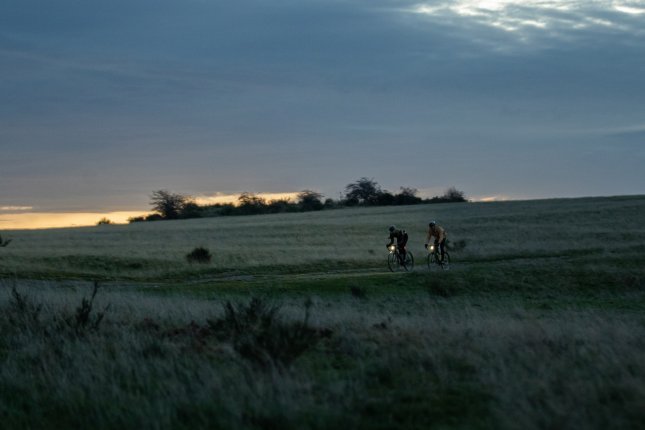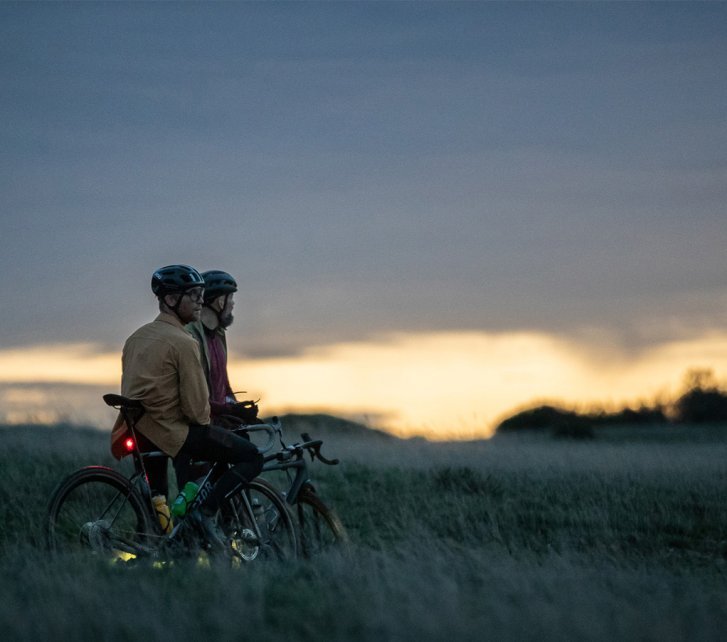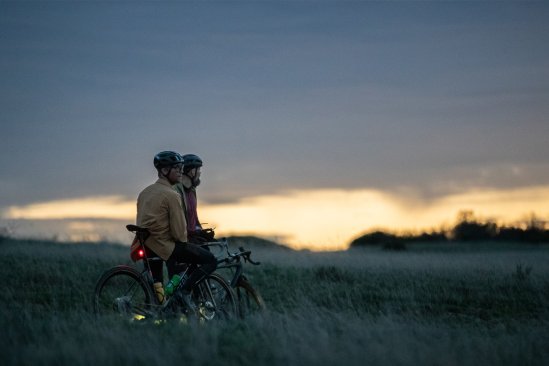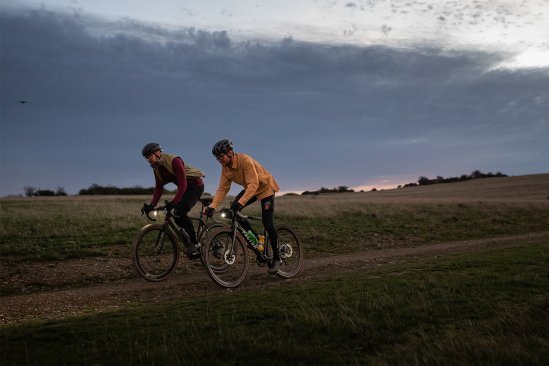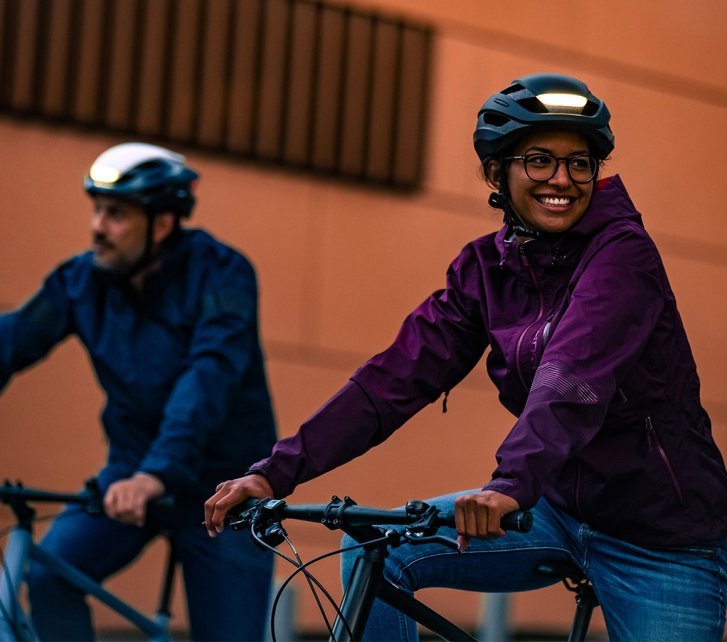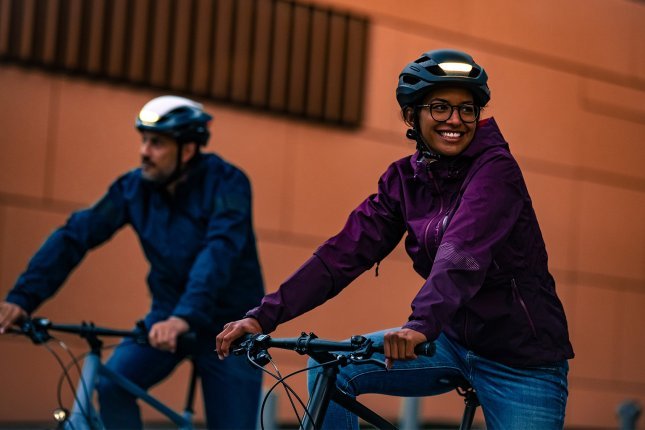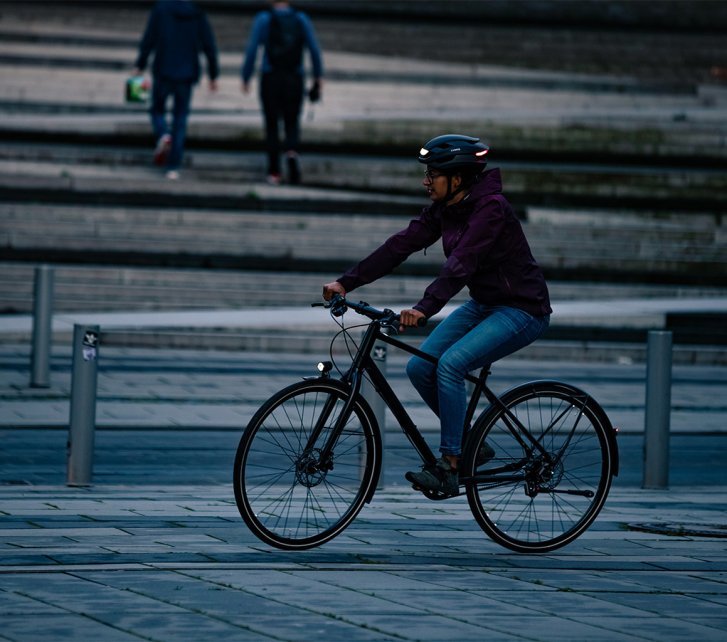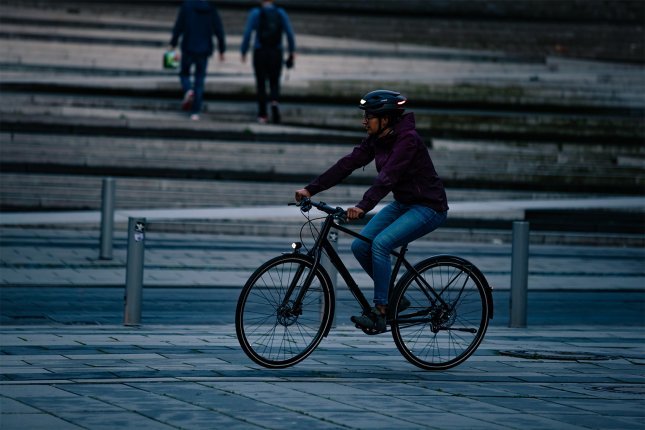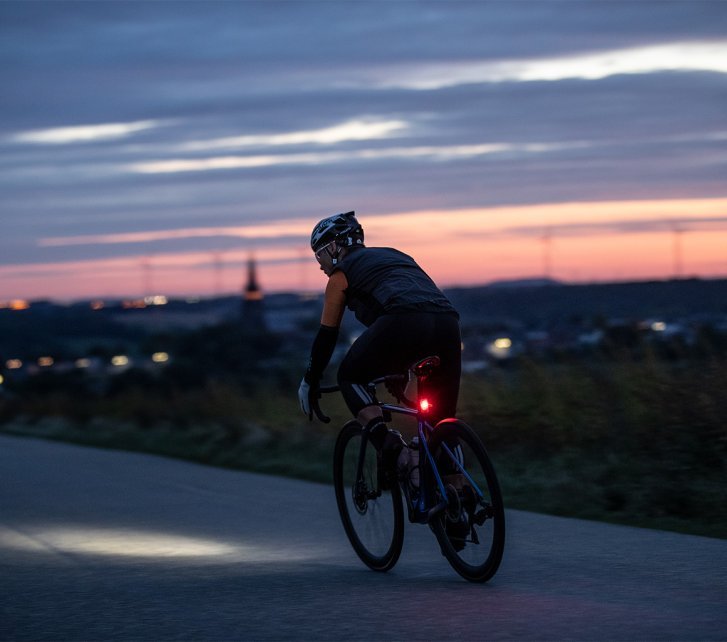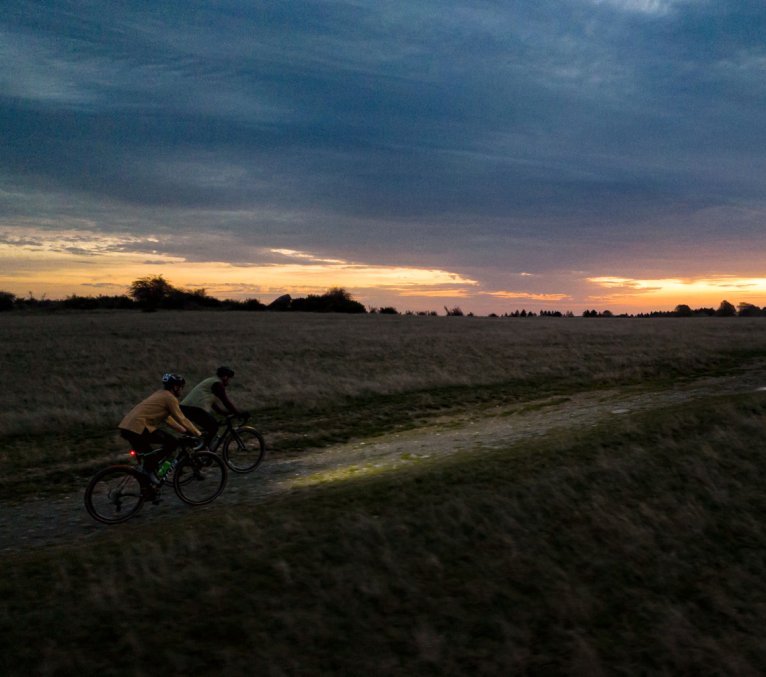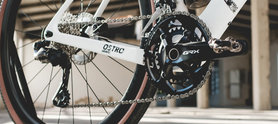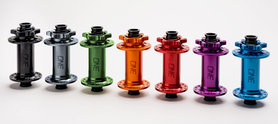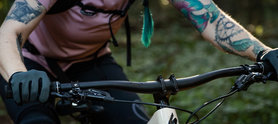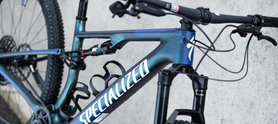Bike Lights: The Ultimate Guide to Proper Bicycle Lighting
With the right bike light, you’ll ride safely and legally through the dark. Here’s everything you need to know.
Do you regularly ride your bike to work, university, the shops or for sports? Or is cycling your sport itself? Then you simply can’t ignore the topic of bike lighting. With the right lights, you’ll see more, be seen better, and avoid trouble or fines during a police check. But what exactly counts as the “right” bike light? Which lighting is StVZO-compliant? Does a rechargeable bike light or a dynamo-powered light suit you better? How do you correctly adjust your light so it doesn’t dazzle others? And what should you consider when riding more sportively on a road bike, gravel bike or mountain bike? Keep reading to find your perfect lighting setup!
Safe on the road at dusk: Bright bike lights for optimal visibility. © bc GmbH
StVZO-Compliant Bike Lighting
To ride your bike safely and legally in Germany in the dark, your bicycle lighting must comply with the requirements of the German Road Traffic Licensing Regulations (StVZO).
According to the StVZO, the following lights are mandatory:
- a white front headlight
- a steady (non-flashing) red rear light
We also recommend using front and rear lights with a standlight function – this keeps you visible even when stopped briefly at traffic lights. Since 2013, it’s up to you whether you choose rechargeable or battery-powered bike lights or dynamo-powered lighting. The main thing is that your lights carry a K-number (wave symbol + letter K + number combination), which indicates official approval by the German Federal Motor Transport Authority. In our shop, you can easily find StVZO-compliant lights using a filter.
Your lights don’t have to be permanently attached to your bike or carried at all times. However, as soon as conditions require it, you must have them mounted – and, of course, switched on. Otherwise, you’re expected to walk your bike. To avoid being left in the dark, check the charge level of your battery or accumulator regularly and do a quick light check before every ride.
Rely on bright rear lights for your evening ride! © bc GmbH
Cyclists use lights to stay visible in low-light conditions. © bc GmbH
Additional Light Functions for Extra Visibility and Safety
If you regularly cycle in the city, the following upgrades are worth considering:
- Daytime running light: Special bike lighting for daytime use improves your visibility in bright conditions.
- Light sensor: As soon as it gets darker, the dipped beam switches on automatically. Gone are the days of forgetting to turn on your lights in well-lit city traffic.
- Rear brake light: A rear light with a brake function signals when you’re slowing down – a real safety bonus in urban traffic.
- Two front headlights and/or several rear lights: These are permitted and greatly increase your visibility. An additional rechargeable light is especially useful if your dynamo-powered lighting is older or not very bright.
If you often ride in rural areas, consider a front light with a high beam and cornering light. However, if most of your rides are within the city, this feature is not usually helpful – you may only use high beam when you’re alone on the road.
What you’re also allowed to do: use indicators. Since 2024, turn indicators have been permitted on single-track bicycles, and on cargo bikes with large loading areas even for a bit longer. However, permanently flashing lights are not allowed on your bike! Flashing lights may only be used as additional lighting on your helmet, clothing or backpack – as long as they don’t dazzle anyone. We also recommend wearing reflective clothing and high-visibility accessories to make yourself even more noticeable in traffic. You can find more on this topic in our article High-Visibility for Cyclists: Being Seen in Traffic.
Also important: helmet lights, such as those used by some mountain bikers, count only as additional lighting and cannot replace the mandatory lights and reflectors. As soon as your helmet light can dazzle others, it is prohibited for road use – which excludes most of these products.
More visibility, more safety: Helmets with integrated lighting make you stand out in traffic – without dazzling others.
StVZO-Compliant Bike Reflectors
In addition to the mandatory lighting, certain reflectors are also required on your bike – at all times, even in broad daylight!
According to the StVZO, these bike reflectors are mandatory:
- a white front reflector
- a red rear reflector (also called a Z-reflector, which must not be triangular)
- two yellow reflectors on each pedal (one facing forward and one facing backward)
- side reflectors on each wheel – you can choose between:
Important: Reflectors also need to be StVZO-approved. The front and rear reflectors may be integrated into the light unit – but only if the lighting is permanently mounted on the bike.
Adjusting Your Bike Light Correctly: Observe the Cut-off Line
It’s especially important to cycle through the dark without dazzling others. This isn’t just good manners – it’s a legal requirement set out in the German Road Traffic Licensing Regulations (StVZO). To avoid blinding other road users, your bike light must be adjusted so that it illuminates only the road ahead – not the surroundings, oncoming traffic or pedestrians. Every StVZO-approved headlight shows a clear “cut-off line” when switched on. This is the transition between the bright area of the beam and the darker surroundings – and it helps you set your light correctly.
Here’s how to adjust your bike light properly:
- Find a flat surface – for example, an empty car park or a quiet street.
- Tilt the headlight so that the upper edge of the light beam is visible on the road in front of you – not higher.
- If you ride faster (and want to see further), this line can be a bit farther ahead – but always on the road, never at other people’s eye level.
- If you can’t see the end of the beam on the road anymore, your light is set too high. Tilt it downwards to avoid dazzling oncoming traffic!
Also make sure that removable lights don’t shift out of position while riding, mounting or dismounting – otherwise your careful adjustment will be lost.
A bike light with high beam shines – just like on a car – beyond the cut-off line of your dipped beam. This gives you a longer and brighter view, but it can dazzle others. Therefore, the following rules apply when using high beam:
- Dip your lights early when other road users approach!
- High beam must be switched off in built-up areas – it’s not allowed there.
Lumen and Lux Explained Simply
When you start looking into bike lighting, you’ll quickly come across two terms: lumen and lux. But what do they actually mean? What’s the difference between lumen and lux? Are they comparable? And how do these values help you choose the right light?
Lumen (lm) is the unit of luminous flux and indicates how much total light a lamp emits. Simply put: lumen measures brightness. The higher the lumen value, the brighter the light. However, lumen doesn’t tell you how the light is distributed on the ground – whether it’s focused, wide, near or far.
Lux (lx) is the unit of illuminance and measures how much light (in lumen) falls on a specific surface area. For you, this means: lux shows how well the road ahead of you is illuminated. But beware: manufacturers often measure lux on different surfaces and at varying distances. The process isn’t standardised, so lux values are only partly comparable between headlights from different brands.
Many rechargeable or battery-powered bike lights come with different brightness levels. This allows you to adjust the light intensity to your surroundings and save power when needed.
Here’s our recommendation:
| Area of Use | Lux | Lumen |
| City, well-lit (cycle) paths | 30-60 | 100-200 |
| Unlit roads or cycle paths | >70 | >300 |
| Off-road or unpaved trails | >100 | >700 |
Tip: A high beam with 1,000 lumens or more is ideal if you ride at higher speeds on unlit paths or roads outside the city.
In the end, what really matters is your lamp’s light beam. You need to clearly see what’s ahead of you. Depending on your speed, route and surroundings, the requirements for illumination can vary. Manufacturer photos or beam pattern tests can help you better assess how the light is distributed on the road.

Buying Guide: Finding the Right Bike Lighting for Your Ride
Want to find the perfect light for your bike and how you ride? Our buying guide will show you how. Let’s get started!
City Bikes, Touring Bikes and Other Bikes with Hub Dynamo
On trekking and city bikes – as well as on touring bikes and some other models – you’ll usually find a fixed lighting system powered by a hub dynamo. It sits inside the front wheel hub, runs quietly and reliably. While there’s a slight loss of efficiency compared to bikes without a hub dynamo, it’s barely noticeable in practice. Sidewall dynamos are now mostly found on older bicycles. They create more pedalling resistance and don’t always perform reliably in wet or damp conditions. Good to know: high beam is rare on dynamo-powered systems, as it requires a lot of power. Typically, high beam is powered by the e-bike battery or an external one. Also note: a lamp designed for an e-bike battery cannot be used with a dynamo – and vice versa.
For your daily commute, a bike with a permanently installed lighting system is highly practical: your lights are always ready to use and can neither get lost nor stolen.
The leading manufacturers in this segment include Busch + Müller and Axa for mid-range, price-conscious options. For premium models, check out Supernova and SON. We recommend choosing a headlight with a standlight function – a small capacitor stores energy so that your lights stay on at traffic lights, keeping you visible even when stopped.
A city bike with a hub dynamo provides reliable lighting – perfect for nighttime commutes in the city. © bc GmbH
Road Bikes, Gravel Bikes and Other Bikes without Dynamo
If your bike doesn’t have a fixed lighting system, rechargeable or battery-powered lights are a great solution. Some can be permanently mounted, while others attach with a quick-release or O-ring to the handlebar, seatpost or rear stay – usually without tools. For sporty or minimalist bikes, quick-release mounts are a smart choice: they’re easy to attach and remove, and when detached, they don’t spoil your bike’s clean look.
According to StVZO regulations, your rechargeable lights must include a battery charge indicator so you can see in time when to recharge. The battery life depends on the model and – if applicable – on the brightness mode you choose. Don’t want to risk forgetting your light? You can retrofit a hub dynamo lighting system – but be aware that it’s often complex and not cheap.
We offer rechargeable lights from Sigma, Cateye and Lezyne in both entry-level and mid-range categories. Busch + Müller also provides a wide selection. The brand Garmin, best known for GPS devices, offers two innovative rear lights in its Varia Radar range – one with a vehicle-approach warning function and another with a camera function for recording accidents.
A special highlight in our range is Lightskin. The German manufacturer offers handlebars and seatposts with integrated LED battery lighting – a small revolution, especially for your stylish, high-quality city or touring bike, where you don’t want to spoil the clean design with an external lamp.
Battery-powered lights on a bike ensure clear visibility during evening rides without affecting the bike’s sleek design.
E-Bike (Road Use)
For StVZO-compliant e-bikes, the power for your fixed lighting system usually comes directly from the main battery. Thanks to the high battery capacity, e-bike lights can achieve impressive brightness levels, and there’s plenty of power available to operate a high beam as well. When upgrading or replacing parts, always check that the light is compatible with your e-bike’s battery and drive system! You’ll find the relevant specifications in the product description. And if you ever run your battery flat, there’s usually no need to panic – most e-bikes reserve enough remaining power to keep the lights running.
The leading high-end brands in this segment are Supernova and Lupine, while Busch + Müller and Lezyne also offer top-quality products. For affordable entry-level lighting, Axa and Cateye provide solid options.
(E-)Mountain Bike
Out in the dark forest or when things get sporty on your MTB or e-MTB, a helmet light is the ultimate choice. The beam is powerful and, most importantly, always exactly where you’re looking – a real advantage off-road! What would be unacceptable on public roads due to glare makes perfect sense out on the trails. For optimal visibility, combine your helmet light with a (StVZO-compliant) handlebar light – and don’t forget a rear light, which you’ll need for the ride to and from the woods anyway. On an e-MTB, you can also use a permanently mounted light powered directly by the e-bike’s battery.
If you’re aiming for maximum brightness and premium quality, Lupine is hard to beat. The solid mid-range option comes from Sigma, whose Buster series offers well-designed helmet lights for both beginners and ambitious riders – and the brand has made impressive progress in this segment in recent years.
One more important point to finish with: stick to the main forest roads during your night rides! Wildlife there is accustomed to people and vehicles. Singletracks deep in the woods should be off-limits at night – that’s the animals’ retreat. And honestly, even on the forest roads, it’s best to avoid riding in the middle of the night to give wildlife the peace it deserves.
FAQ: Bike Lighting
Does my bike light need to be StVZO approved?
Yes. If you ride your bike on public roads in Germany, both your front and rear lights must be StVZO approved – you can recognise this by the K-number marking. If you only ride off-road or on forest paths, this requirement doesn’t apply.
How many lumens does a good bike light need?
The lumen figure alone isn’t the most important factor – the lux value matters more, as it shows how well the road ahead is actually illuminated. Around 30–50 lux is usually enough for city riding. For unlit roads or paths, 70–100 lux is recommended. Dedicated MTB helmet lights often reach 1,000 lumens or more. Remember: it’s not just about brightness, but also the shape and focus of the beam!
What’s the difference between a battery light and a dynamo light?
Dynamo lighting is powered continuously while you ride and is always ready to use. Battery or rechargeable lights are more flexible to mount and often more powerful, but they need regular recharging. Modern hub dynamos have much lower resistance compared to old side-runner dynamos.
Can I use a helmet light on public roads?
No. A helmet light follows your line of sight and doesn’t have a defined cut-off line, meaning it can dazzle oncoming traffic – it’s therefore not StVZO compliant. It’s great for off-road night rides, but not suitable for the street.
What does “daytime running light” mean on a bike headlight?
Just like on a car, a daytime running light ensures you’re more visible to other road users – especially drivers – even in bright daylight.
Do I need a special light for my e-bike?
Yes, if you want to connect the lighting system directly to your e-bike battery. E-bike lights are designed for the higher voltage of the motor system and have specific connectors for manufacturers such as Bosch, Shimano or Brose. If you’re unsure, contact our customer service team!
Is flashing bike lighting allowed?
No. According to the StVZO, a flashing mode is not permitted for the main lights mounted on your bike in Germany. Some products offer this option, but it may only be used off-road or abroad. You may, however, attach flashing lights to your helmet, clothing or bags – as long as they don’t dazzle other road users.



